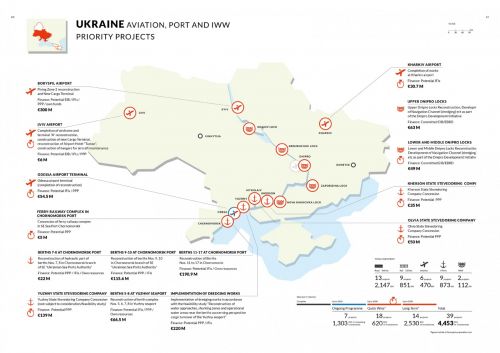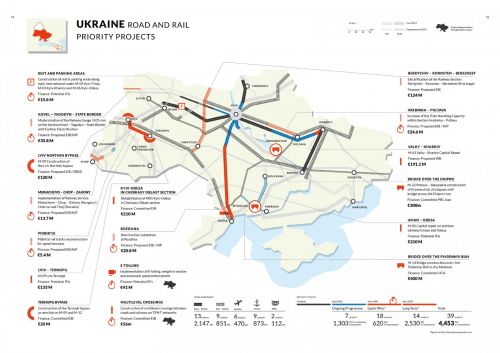The European Commission and the World Bank presented the Indicative Trans-European Transport Network (TEN-T) Investment Action Plan in mid-January. The action plan identifies priority projects in Armenia, Azerbaijan, Belarus, Georgia, Republic of Moldova and Ukraine. The projects require an estimated investment of almost EUR 12.8 billion and foresee a total of 4,800 kilometers of road and rail, 6 ports, and 11 logistics centers. Those projects will make possible the construction and rehabilitation of new and existing roads, rail, ports, airports as well as logistical centers and border crossing points.
The objective of the TEN-T is to connect the continent both from the west to the east and from the north to the south in the shortest possible time by “inserting the necessary segments of the transport network in the right places, thereby creating a single network instead of the existing transport mosaic.” "Enhanced transport connectivity both within the Eastern Partnership region (EaP), and between the EaP region and the EU has the potential to bolster economic growth and create job opportunities. The Plan will also serve to highlight the importance of road safety as well as digital solutions in new projects, and to align design standards with current EU practices," European Commissioner for Transport Violeta Bulc said.
According to European Commissioner for European Neighborhood Policy and Enlargement Negotiations Johannes Hahn, completion of the Indicative TEN-T Investment Action Plan is a joint commitment to deliver tangible results for citizens across the region, and the plan will assist decision-makers in prioritizing strategic investments in transport infrastructure.
The projects included in the Indicative TEN-T Investment Action Plan were identified together with the Eastern Partnership countries and with the assistance of the international financial institutions. Those projects will make possible the construction and rehabilitation of new and existing roads, rail, ports, airports as well as logistical centers and border crossing points.
"A key element of the investment plan was to assess realistic spending space estimates for implementation of the plan. This involved an assessment of each country’s fiscal space, their ability to absorb and implement funds and allocate national budget funds to transport," the investment plan states.
According to Ukraine’s Minister of Infrastructure Volodymyr Omelian, implementation of the Indicative TEN-T Investment Action Plan’s projects in Ukraine is expected to be financed by the European Investment Bank (EIB) and the World Bank, as well as through public-private partnerships. "The Ukrainian transport network is becoming part of the European Union’s strategic transport and logistics corridors for the first time. Implementation of the projects that are included in the Indicative TEN-T Investment Action Plan will significantly deepen Ukraine’s infrastructural integration with Europe and make it an organic part of the European transport network in the future," the minister said.
The priority investments include both short-term projects to be completed by 2020 and long-term projects aiming to improve transport links on the TEN-T by 2030. Part of the projects outlined on the European Commission’s indicative TEN-T map on the territory of Ukraine involve existing infrastructure facilities and part involve those that have not yet been created.
Ukraine first appeared on TEN-T maps published by the European Commission in late autumn 2018. Which are the European Commission’s priority infrastructure projects in Ukraine?
Airports and seaports
Three of the projects are in the Yuzhny seaport, four in the Chornomorsk seaport, and one each in the Kherson seaport and the Olvia seaport.
The European Commission’s Indicative TEN-T Investment Action Plan includes the following projects at the Yuzhny seaport: concession of the Yuzhny State Stevedoring Company (to be financed with EUR 139 million through potential public-private partnership), reconstruction of the berths Nos. 5, 6, 7, and 8 (to be financed with EUR 66.5 million from international financial institutions, public-private partnership, and the seaport’s own funds), performance of dredging works in accordance the feasibility study “Reconstruction of Water Approaches, Shunting Zones, Operational Water Areas, Taking Account of the Yuzhny Seaport’s Prospective Cargo Turnover” (to be financed with EUR 220 million from potential public-private partnerships and international financial institutions). All these projects are to be implemented by the year 2020.
The projects in the Chornomorsk seaport are concession of a ferry-and-railway complex (by 2020), reconstruction of the hydraulic structures at the berths Nos. 7 and 8, reconstruction of the berths Nos. 9 and 10, and reconstruction of the berths Nos. 11-17 (all to be implemented by 2030). The projected amounts of investment in these berth reconstruction projects are EUR 22 million, EUR 115.6 million, and EUR 190.9 million, respectively.
The Indicative TEN-T Investment Action Plan also includes concession of the Olvia and Kherson seaports in the coming year.
The document also provides for implementation of river navigation projects. In particular, the short-term plan (to be completed by 2020) includes reconstruction of the locks on River Dnipro (Zaporizhia and Nova Kakhovka) and dredging of the navigation channel in the lower and middle parts of river. It also provides for performance of similar work in the upper part of the river and the locks in Kaniv and Kremenchuk over a period of 11 years. These works are expected to be financed with a total of EUR 112 million in loan funds from the EIB and the EBRD.
In the aviation industry, four airports are included in the Indicative TEN-T Investment Action Plan. The document provides for completion of the reconstruction of the passenger terminal at the Odesa airport.
At the Lviv airport, it provides for completion of the reconstruction of the terminal A (by 2020), reconstruction of the airfield complex, reconstruction of the Tustan airport hotel, construction of a new cargo terminal, and construction of hangars for aircraft maintenance (by 2030).
At the Boryspil airport, the document provides for reconstruction of the second flying zone and construction of a new cargo terminal over a period of 10 years. Together, these projects are projected to cost EUR 300 million, which, according to the infographics provided by the European Commission, is expected to come from various sources, including the EIB, international financial institutions, the airport’s own funds, and public-private partnership.
Roads and railways
Out of the EUR 2 billion that the European Commission intends to invest in railway projects in all the six Eastern Partnership countries under the action plan, the largest (EUR 850 million) could be invested in projects in Ukraine. Of the 16 projects in Ukraine, nine are to be implemented on Ukrainian railways.
The board chairman of the Ukrainian Railways joint-stock company (JSC Ukrzaliznytsia), Yevhen Kravtsov, previously named five of these projects, noting that Ukrzaliznytsia was fully prepared for their implementation. They include a project for modernization of the Kovel–Yahodyn–state border railway stretch (1435 mm gauge) and its subsequent electrification, reconstruction of railway tracks at the Pidbirtsi train station (Lviv region), construction of a new traction substation at the Rozdilna train station, electrification of the Berdychiv–Korosten–Berezhest railway stretch, and increase of the throughput capacity of the Hrebenka–Poltava railway section.
Among the projects that were not mentioned by Kravtsov but are listed for implementation by 2020 in the Indicative TEN-T Investment Action Plan is modernization of the railway infrastructure on the Mukacheve–Chop (Ukraine)–Zahony (Hungary)/ Cierna nad Tisou (Slovakia). This project is estimated to cost EUR 13.7 million and the likely sources of funding are the EIB and the Neighborhood Investment Platform (NIP).
In the road sector, the projects listed for implementation in Ukraine in the next few years include introduction of E-Tolling, Weigh-in-Motion, and automatic speed control systems (which are expected to cost a combined EUR 41 million, potentially from international financial institutions), construction of multi-level crossings between railways and highways on the TEN-T network (EUR 56 million, committed by the EIB), and construction of six zones for parking and recreation along Kyiv–Chop, Kyiv–Kharkiv, and Kyiv–Odesa highways (EUR 15.6 million, potentially from international financial institutions).
The Indicative TEN-T Investment Action Plan also includes projects for construction of a Lviv northern bypass road and construction of a Ternopil bypass road as a new link on the M-09 (Lviv – Rava-Ruska) and M-12 (Stryi – Ternopil – Kropyvnytskyi – Znamianka) highways; reconstruction of the M-09 highway.
Also included on the list of projects in Ukraine are reconstruction of the Kyiv–Odesa section of the M-05 highway in the Cherkasy region (EUR 210 million, committed by the EIB); overhaul of the Uman–Odesa section of the M-05 highway (EUR 210 million from international financial institutions); overhaul of the Valky–Kharkiv section of the M-03 (Kyiv–Kharkiv–Dolzhanskyi) highway (expected to be financed with EUR 191.3 million from the World Bank).
In addition, the European Commission’s Indicative TEN-T Investment Action Plan includes construction of two bridges – one across River Dnipro in Kremenchuk and one across the Pivdennyi Buh River in Mykolaiv. Construction of the bridge in Kremenchuk is expected to cost EUR 300 million (loans committed by Eximbank of China). Construction of the bridge in Mykolaiv will cost EUR 400 million (committed by the Japan International Cooperation Agency, JICA).
“The existence of such a plan immediately resolves a lot of strategic issues in the process of finding funds for financing their implementation. It is much more comfortable for large banks and international financial institutions to consider investments that are part of large infrastructure systems,” said Andrii Shkliar, an expert with CFTS Consulting.
In general, according to Shkliar, the inclusion of Ukraine in the European Commission’s Indicative TEN-T Investment Action Plan is a positive step because it gives the country guidelines for medium- and long-term infrastructure development. “There is a reason why the Ukrainian Ministry of Infrastructure mandated inclusion of all the investment projects related to the development of the TEN-T network in the Strategic Action Plan for implementation of Ukraine’s National Transport Strategy,” he said.



